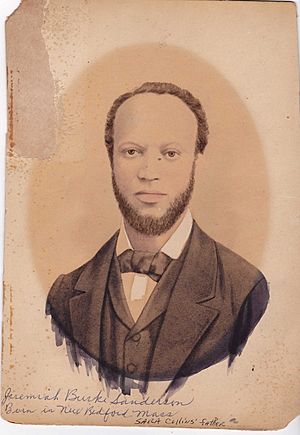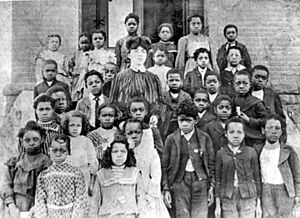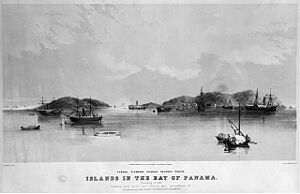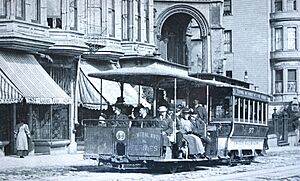Jeremiah Burke Sanderson facts for kids
Quick facts for kids
Jeremiah Burke Sanderson
|
|
|---|---|
 |
|
| Born | August 10, 1821 |
| Died | August 19, 1875 (aged 54) |
| Occupation | Educator |
| Known for | Influential educator and activist for rights of colored people in early California |
| Spouse(s) | Catherine Elizabeth Molyneaux |
Jeremiah Burke Sanderson (born August 10, 1821 – died August 19, 1875) was an important American abolitionist. He worked hard for the civil rights and educational rights of Black people in the United States. He grew up in New Bedford, Massachusetts, where he saw many famous people working to end slavery. These included Frederick Douglass and Harriet Tubman. Learning from them and studying helped him become a strong speaker for Black rights in the U.S.
Sanderson is famous for starting the first public school for Black children in California. He was a very important leader and teacher on the West Coast, especially for improving education and rights for Black people.
Contents
Early Life in Massachusetts
Growing Up in New Bedford
Jeremiah Sanderson was born on August 10, 1821. His parents were Daniel Sanderson and Sarah Burke. They lived in New Bedford, Bristol County, Massachusetts. His mother, Sarah, was part Wampanoag Native American. His father, Daniel, was part African American and part Scottish. Daniel Sanderson left the family when Jeremiah was nine years old. Jeremiah Sanderson received a good education and loved to learn.
Important Influences
The place where Sanderson grew up helped him become a powerful leader. In his early years, he saw Black Americans vote and attend public schools. He was surrounded by the work of famous abolitionists. These included Harriet Tubman and William Lloyd Garrison. Later, he worked closely with Frederick Douglass and William C. Nell. They influenced him greatly.
His Jobs
In New Bedford, Sanderson worked as a barber during the week. On Sundays, he would give speeches at local churches. He was not officially a minister at that time.
Fighting for Rights
Jeremiah Burke Sanderson became the secretary of the New Bedford Colored Citizens group when he was just nineteen. In 1840, he met William C. Nell and Frederick Douglass. They were both abolitionists from Boston, Massachusetts. Sanderson became good friends with them and worked with them for many years.
Throughout the 1840s, Sanderson traveled to cities like Lynn, Massachusetts and New York. He gave speeches about how terrible slavery was. One speech he gave in Lynn was almost printed in the New-York Tribune newspaper. In 1841, Sanderson gave a speech at the Massachusetts Anti-Slavery Society meeting. Many famous abolitionists were impressed by him. In 1853, Sanderson was chosen as a delegate for the National Convention of Colored People. In 1854, he joined the State Council of Colored People of Massachusetts.
His Family
On February 4, 1849, Jeremiah Sanderson (age 27) married Catherine Molyneaux (age 19). They were married in New Bedford, Massachusetts. They had a large family with eight children. Their children were William, Mary, Florence, Kate, Sarah, Jeremiah, Charles, and Abraham.
In 1854, Jeremiah Sanderson moved to California. He left his wife and four children behind in New Bedford. He hoped to earn more money there. Later, his family joined him in California before 1860. Letters Sanderson wrote show how much he missed his family during this time. Sanderson's daughter, Mary Sanderson Grasses, later became the first Black public school teacher in Oakland, California.
Moving to California
Sanderson started a new part of his life when he left his family. He boarded a ship called the S. S. Sonora. He sailed to California because people were talking about great wealth there. The California Gold Rush had started in 1849. Also, California was a free state, meaning slavery was not allowed. This made it a good place for Sanderson and other Black Americans. He hoped to get rich and then return to his family.
When he arrived in San Francisco, people quickly noticed his talent for giving powerful speeches. He immediately started giving speeches at anti-slavery events. This was the beginning of Sanderson's work in the West. He worked to support Black rights and education. In the years that followed, he opened schools for Black children. He also got public money for these schools. He gave speeches in churches and encouraged equal rights for Black and white people.
Sacramento Efforts
Sanderson's first stop after San Francisco was Sacramento. He quickly saw that over two hundred Black children of school age had no public school. There was only one private school for Black children. It was in the basement of a teacher named Elizabeth Scott.
Sanderson wanted all Black children to have an equal chance to learn. He began talking with the Sacramento Board of Education. He hoped to get public money for a Black school. Sanderson worked hard, and the school board agreed to fund a Black school. It opened in 1855 with Sanderson as the teacher. Soon after, he noticed that the money provided was not enough. After more letters to the school board, he successfully got more funds. Sanderson also took an exam and earned a teaching certificate. This made him one of the few Black teachers in the state with this certification.
Besides improving education, Sanderson was also a civil rights activist in Sacramento. He became the secretary for the first convention of the Colored Citizens of California. He also helped publish pamphlets with ideas from the conference. He continued as secretary for the second convention. He also took on more duties on the free press committee.
From 1856 to 1858, we don't have much information about Sanderson's actions. Letters between Sanderson and his family show this was a hard time for him. He missed his family very much.
San Francisco Work
In 1859, Sanderson returned to San Francisco. He became a teacher at a public Black school. This school was in the basement of a church. When he arrived, he noticed that very few Black children were in school for the size of the city. Sanderson sent letters to parents of Black children. He urged them to use the public school system.
Sanderson kept working to make education better for Black children in San Francisco. He contacted the school board again. He got money to build a new school. This new school, called the Broadway School, opened in 1864. Five years later, Sanderson became the principal of the school. However, his time as principal was short. His Black assistant quit, and a white woman was hired. At that time, it was not accepted for a white woman to work for a Black man. So, he had to step down and become a teacher again.
Stockton Contributions
Soon after losing his principal job, Sanderson moved to Stockton, California. He continued to improve the education system for Black children by teaching. His excellent teaching made him well-known throughout California. Some Black families even sent their children to Sanderson's school from far away. Like before, Sanderson kept writing letters to the school board. He and many others were happy with the school's progress.
Oakland Focus
Sanderson spent his last days in Oakland, California. His main focus shifted to church matters. While living in Oakland, he became the secretary of the 1875 annual conference. This was for the African Methodist Churches of California.
His Death
Sanderson died on August 19, 1875. He was hit by a Southern Pacific train and died instantly. During his life, Sanderson greatly improved education for Black children in California in the 1800s. He opened schools, got money for them, and taught in them. His skill in public speaking also helped advance the basic rights of Black citizens. Sanderson is remembered for his big contributions to Black civil rights.
Images for kids








